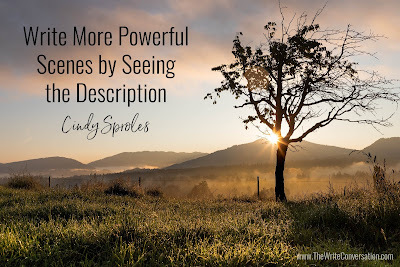Edie Melson's Blog, page 108
November 10, 2022
A Pilgrim’s Handbook

by Audrey Frank @AudreyCFrank
Blessed are those who dwell in your house; they are ever praising you. Blessed are those whose strength is in you, whose hearts are set on pilgrimage. As they pass through the valley of Baka, they make it a place of springs; the autumn rains also cover it with pools. Psalm 84:4-6
The table was laden with steaming piles of hot, puffy bread fresh from the oven. The grateful pilgrims gathered 'round, holding out plastic cups soon to be filled with sweet milky tea. They had journeyed far. Some had walked miles over rough mountain passes, narrowly escaping soldiers along the way who sought to capture these renegade followers of Jesus. Others fled their home countries long ago, seeking safe refuge in nations where Christian worship was allowed.
No matter their origin, within each of these pilgrims’ hearts rose a hidden highway, a pathway leading ever higher to the One they loved. The One who was worth the risk. The Messiah who gave His own life for them. They had chosen to follow Him, and they were never turning back. Some had been imprisoned. Others tortured. But every heart implicitly believed His promise to turn the valley of tears into a place of springs.
And here He was, doing it right before my eyes as they enjoyed rare fellowship with the family of God. Weeping and laughter mingled together and rose like a song of thanksgiving on the pilgrim way.
I have the honor of working with modern-day pilgrims, some of whom, like the first Puritan pilgrims at Thanksgiving, have escaped persecution and found fellowship in strange lands. Others have not been able to flee, yet their hearts are set on pilgrimage even as they dwell among their persecutors.
Their lives are like a pilgrim’s handbook, showing us the way.
The pilgrim invitation is an invitation to dwell, to settle. We are beckoned to belong to God’s family, even as we are displaced in a world increasingly not our home.
Pilgrims are known for their persistent praise along the path. They are famous for strength which makes no sense. They keep going against all odds, for their hearts are set on traversing another highway, one that leads to a heavenly country where there will be no more tears or persecution.
Pilgrims pass through valleys of weeping and change the landscape. Sorrows become springs of life for other travelers.
Pilgrims leave a legacy. In the autumn season of their sojourn, they leave pools of wisdom for those who will follow behind.
Fellow pilgrim, one day this highway will lead us home. There will be a table there, made ready. We will gather around it with family from every tribe, nation, and tongue. The valley of Baka will be like a distant dream. Thanksgiving will be a way of life.
Lord, I will set my heart on pilgrimage today. Amen.
TWEETABLEA Pilgrim's Handbook, insight from @AudreyCFrank on @EdieMelson (Click to Tweet)
 Audrey Frank is an author, speaker, and storyteller. The stories she shares are brave and true. They give voice to those whose words are silenced by shame, the hard things in life that don’t make sense, and the losses that leave us wondering if we will survive. Audrey and her family have spent over twenty years living and working among different cultures and world views, and she has found that God’s story of redemption spans every geography and culture. He is the God of Instead, giving honor instead of shame, gladness instead of mourning, hope instead of despair. Although she has three different degrees in communication and intercultural studies, Audrey’s greatest credential is that she is known and loved by the One who made her.
Audrey Frank is an author, speaker, and storyteller. The stories she shares are brave and true. They give voice to those whose words are silenced by shame, the hard things in life that don’t make sense, and the losses that leave us wondering if we will survive. Audrey and her family have spent over twenty years living and working among different cultures and world views, and she has found that God’s story of redemption spans every geography and culture. He is the God of Instead, giving honor instead of shame, gladness instead of mourning, hope instead of despair. Although she has three different degrees in communication and intercultural studies, Audrey’s greatest credential is that she is known and loved by the One who made her.Audrey is the author of Covered Glory: The Face of Honor and Shame in the Muslim World (Harvest House Publishers), an outpouring of Audrey’s heart to introduce others to the God of Instead. Shame is not unique to the developing world, the plight of the women behind veils, young girls trafficked across borders; shame is lurking in hearts everywhere. Through powerful stories from women around the world, Covered Glory illuminates the power of the Gospel to remove shame, giving honor instead. Available at favorite booksellers: BARNES & NOBLE , BOOKS A MILLION, AMAZON.
Published on November 10, 2022 22:00
November 9, 2022
What Are You Doing with the Words God Gives You?

by Julie Lavender @JLavenderWritesMy daughter helped three-year-old Benaiah call me two weeks ago while I was attending the Florida Christian Writers Conference. It just so happened that my phone rang during a fifteen minute break, just before a keynote session. I stood outside the chapel and chatted with my grandson on FaceTime.
My observant grandbaby didn’t recognize my surroundings and asked, “What are you doing, Grandmommy?”
I couldn’t think how to explain a writers conference to Benaiah. How do I tell a three-year-old that my retreat with other Christian writers refreshes me spiritually? Revives me emotionally. Invigorates me mentally. Awakens my muses. Renew old friendships and initiates new ones. Teaches me about this craft that I love. And soothes my weary soul.
“Grandmommy is at a meeting, Benaiah. What are you doing? Is it almost bathtime?”
He didn’t want to answer my questions, but instead, wanted me to elaborate.
“What are you doing, Grandmommy?” This time, he emphasized the word “doing,” and I interpreted his sentence: “I don’t understand what you mean by this meeting, and I’d like a little bit more explanation.”
“Grandmommy is at a meeting to talk about books. Remember Grandmommy’s book that I wrote about Jesus? Grandmommy is here to talk to people about books like that one.”He seemed satisfied with that answer, and we talked about Power Rangers and chicken nuggets and choo-choo trains and horses and daddy’s guitar and bath toys.
The next night when Benaiah asked to call Grandmommy again, I didn’t pick up. My daughter Jenifer explained, “Grandmommy is still at her meeting, and she can’t answer the phone. We’ll try her again another time.”
My daughter told me later that his response came quickly,. “Grandmommy is telling people about Jesus. She’s talking about books.”
How lovely that my grandson associates talking about books with telling people about Jesus! Isn’t that what we hope to accomplish with any of our words? When he’s a little older, I’ll make sure he understands that writers use their words in lots of ways to tell people about Jesus. A letter to a friend, a sympathy card, a note shared with a family member, a blog post on our website, a guest post to a friend’s website, an online devotion, an in print devotion, a speech read aloud to others, a sermon shared with a congregation, a newsletter, a magazine article, a newspaper article, a story in a compilation, or a published book.
Words put together on paper or computer screen, guided by the Lord, to tell others about him. It’s a gift and calling that I’m thankful for. The gift of writing is one of my greatest blessings from the Lord. I’m thrilled to share words that He’s given me.
During this Thanksgiving season I’m especially grateful for each word, each sentence, each paragraph, each manuscript that the Lord instilled in my heart and mind that eventually became published for others to see. I never take my publishing opportunities or writing gigs for granted, because I know each one is a true blessing from the Lord.
I treasure these blessings from Him, but the Thanksgiving season reminds me to be especially grateful and to give Him all the glory.
Thank you, Benaiah, for reminding me that talking about writing is synonymous with telling others about Jesus. At least in my life and the writers I’m blessed to hang out with at the conferences I attend.
Thank you, God, for the gift of writing, for grandsons, and for conferences. I’m grateful for these blessings and so many more. YOU are always good.
What about you? What writing gifts are you grateful for during this Thanksgiving season?
TWEETABLE
 When Julie counts her blessings, she counts writer friends twice! “Writer friends are double the pleasure,” she boasts. “They get extra points!” Julie considers writing conferences at the top of her blessings’ list, too, and she loves to encourage others to attend conferences. Julie is the author of Children’s Bible Stories for Bedtime (and is excited that the hardback edition released two days ago) and 365 Ways to Love Your Child: Turning Little Moments into Lasting Memories.
When Julie counts her blessings, she counts writer friends twice! “Writer friends are double the pleasure,” she boasts. “They get extra points!” Julie considers writing conferences at the top of her blessings’ list, too, and she loves to encourage others to attend conferences. Julie is the author of Children’s Bible Stories for Bedtime (and is excited that the hardback edition released two days ago) and 365 Ways to Love Your Child: Turning Little Moments into Lasting Memories.
Featured Image: Photo by Glenn Carstens-Peters on Unsplash
Published on November 09, 2022 22:00
November 8, 2022
4 Reasons Writers Need Each Other

by Linda Gilden @LindaGilden
Wait a minute! Isn’t writing a solitary career? Don’t you just get up, fix your coffee, splash a little water on your face, and go to work?
Yes, for sure those are important parts of being a writer. But for many of us, especially those with Socializer personalities, writing in an office all day with no other people around seems like a very lonely profession.
Writers need each other for a number of reasons.1. We need to have friends whose daily schedule looks like ours. Some of us write with a structured schedule and some of write a while, nap a while, and write some more. It’s always good to know when you can’t sleep and finally resort to the computer to make good us of your time, you can usually find another writer who is having the same problem.2. We need writer friends to brainstorm with. When we are stuck on our story line or can’t figure out how to make our nonfiction interesting and creative, it helps to spend a few minutes brainstorming with your writing group. Often they will see angles that you hadn’t thought about.3. We learn from each other. We can learn from reading the writing of others and helping them critique their work to make it better. There is always another writer we perceive as better than we are and it is helpful to become familiar with their structure and style. Study it and figure out why you like that style and why it is successful. Don’t try to copy the style but work the elements you like into your own style.4. We can encourage each other. Who knows the type of discouragement a writer can feel better than another writer. We all need cheerleaders. And if your head cheerleader is another writer, he or she knows just the kind of cheers you need. Cheering for a writer is not a one time, “You can do it! Rah, rah, rah.” It is an ongoing thing. Maybe God has called you to be a cheerleader as well as a writer friend. One time I was almost done with a manuscript and my doorbell rang. It was one of my best cheerleaders with a cone of ice cream. “I knew you were getting close to the end of your book and thought you might need a little treat.” She wouldn’t even come in the house. Just handed me an ice cream cone, gave me a hug, and was on her way. But what a “pick-me-up.” I smiled until I wrote the last word!Whatever your circumstances, always remember your writer friends need you. Don’t let your friends down on that one.
TWEETABLE4 Reasons Writers Need Each Other, insight from author @LindaGilden on @EdieMelson (Click to Tweet)
 Linda Gilden has coauthored 11 books with 5 different coauthors and has #12 and #13 coming out in 2022, adding a new co-author to the list. She loves every one of her coauthors and enjoys collaborating on interesting projects with them. She also has written many books on her own and realizes what a treasure and blessing a good co-author is.
Linda Gilden has coauthored 11 books with 5 different coauthors and has #12 and #13 coming out in 2022, adding a new co-author to the list. She loves every one of her coauthors and enjoys collaborating on interesting projects with them. She also has written many books on her own and realizes what a treasure and blessing a good co-author is.
Published on November 08, 2022 22:00
November 7, 2022
Write More Powerful Scenes by Seeing the Description

by Cindy Sproles @CindyDevoted
We've chosen to write. That's our gift. God has planted the passion and desire inside us, and we've decided to accept it. Honing it requires patience, endurance, and determination, which means learning the writing craft. Within our gift of writing, we are each blessed differently. Some can brainstorm with ease, while others craft unique plotlines that are anything but average.
There are writers whose voice stands out in their writing and others who can write a description.
Recently I taught at the Florida Christian Writers Conference. In my class, a young conferee told me he was thumbing through my books in the bookstore, and what made him buy them was the description. He felt like he could feel the mountain breeze on his face as he read. That was a great compliment. The conversation turned into a nice rabbit trail with some good suggestions for writing engaging descriptions.
Here are a few suggestions:
Practice: Obvious, I know. But I learned to write good descriptions when my friend sent me a picture of a country cottage screened-in porch. "Write what you see." He said. I did, sent it to him, and he returned it. "Nope. Look closer." Over and over, I stared at the picture until it finally sunk in. Practice looking. Practice writing. That led to looking deeper.Looking deeper: There was the key. Looking below the obvious. There was a chair, with a cushion, on a slatted floor with a rug. That was obvious. But looking deeper, I could see wrinkles folded on the cushion that conformed to the person who sat there. I tightened my view, and there it was—the tiny specks of dirt that gathered in the conformed cracks. The ones that stained the yellow-flowered print fabric. It clicked for me. Writing description is not just writing what is obvious. It's going deeper.Use the clouds: Clouds you say? What? Try it. Remember when you were a child and lay in the grass of your yard looking up at the sky? As the clouds passed over, you searched for the animals, trees, or other shapes in the clouds. You were, in your mind, describing…looking deeper. Look at the clouds.Watch a sunrise: No, I mean really…get up early and watch the sun rise. As soon as you see the first crack of morning look at your watch. You will see that within five minutes, darkness will be overtaken, and you will see orange, fade to yellow, fade to white, or even lavender. You'll see streaks appear like you have dipped your fingers in paint and brushed it across the sky. Look closer. Look deeper. Then write what you see. A lot happens in just five short minutes.Seek the depth: When you sit on your porch and watch a bird. What happens around the bird? How does the limb bend when it moves across it? Does it pick at the twig, hold its beak up and stretch? How does it blend into the tree? And what about a breeze? Look deeper.Learn to let go of the normal: Look deep at something, then take in a deep breath, lean back, close your eyes and see it in your head. Let go of what you expect to see and let your imagination show you what your eyes miss.
Our eyes are trained to see the obvious.
We need to see a step before we trip over it. We see the bigger picture. Training our eyes to look deeper takes practice. Good description is not in how much you describe. Instead, it is in the detail of the description. Those little details you must practice to focus on, then translate to the page, open your readers' imagination and suddenly drop them headlong into a moment they can physically feel. Emotion. Did you know description carries emotion? If you want a scene to come to life, perhaps a tender moment between friends, then look at the expressions, the movements, the lines on their faces—how they move, breathe, and listen. Then write what you see. We move from a tear dropping down a cheek to the emotion behind the tear. That is what makes the scene.
The mountains spoke that day. Flecks of light bounced across the sky as the stars fought against the morning, their shimmer slowly fading into a soft violet. Darkness conceded, and fingers of yellow haze shot across the open heavens. A bird dipped into the breeze, and its wings flitted as it caught the lift and soared into the clouds. The morning didn't break—it burst open across the horizon, and there, in the moment of break of day, I saw the true glory of the mountains. My eyes saw the magic that can only be seen from the highest peaks. The summit must be heaven.
Practice. It takes work. You will soon begin to see what it means to really describe a scene.
TWEETABLEWrite More Powerful Scenes by Seeing the Description, insight from author @CindyDevoted on @EdieMelson (Click to Tweet)
 Cindy K. Sproles is an author, speaker, and conference teacher. Having served for a number of years as a managing editor for Lighthouse Publishing of the Carolinas and Ironstream Media, Cindy now works as a mentor, coach, and freelance editor. She is the co-founder of Writing Right Author Mentoring Services with Lori Marett and she is the director of the Asheville Christian Writers Conference. Cindy is also the co-founder of Christian Devotions Ministries and www.christiandevotions.us, as well as www.inspireafire.com. Her devotions are in newspapers and magazines nationwide, and her novels have become award-winning best-selling works. She is a popular speaker at conferences and a natural encourager. Cindy is a mountain girl, born and raised in the Appalachian mountains, where she and her husband still reside. She has raised four sons and now resorts to raising chickens where the pecking order is easier to manage. You can visit Cindy at www.cindysproles.com or www.wramsforwriters.com.
Cindy K. Sproles is an author, speaker, and conference teacher. Having served for a number of years as a managing editor for Lighthouse Publishing of the Carolinas and Ironstream Media, Cindy now works as a mentor, coach, and freelance editor. She is the co-founder of Writing Right Author Mentoring Services with Lori Marett and she is the director of the Asheville Christian Writers Conference. Cindy is also the co-founder of Christian Devotions Ministries and www.christiandevotions.us, as well as www.inspireafire.com. Her devotions are in newspapers and magazines nationwide, and her novels have become award-winning best-selling works. She is a popular speaker at conferences and a natural encourager. Cindy is a mountain girl, born and raised in the Appalachian mountains, where she and her husband still reside. She has raised four sons and now resorts to raising chickens where the pecking order is easier to manage. You can visit Cindy at www.cindysproles.com or www.wramsforwriters.com.
Published on November 07, 2022 22:00
November 6, 2022
3 Reasons to Retire the Worried Writer Inside You

by Kristen Hogrefe Parnell @KHogrefeParnell
Worry. It’s one of Scripture’s “do nots” that we writers sometimes shrug off. I mean, compared to other sins, it seems pretty tame.
But today, I want to talk about why we need to retire the worried writer. And by worried writer, I mean you and me.
Yes, we writers worry about everything. For example:Is my idea even good?Will everyone hate my story?What if I get a bad review?I’ll probably just get another rejection.What if my words offend someone?What if no one buys my book?If I don’t get enough sales, I’ll never get another contract.
Since I think we all struggle with worry at some point, I want to share my personal digging into Scripture and retire the worried writer once and for all… or at least arm ourselves with the ammunition we need to fight this foe.
#1: Retire Worry Because God Said So.
That’s right. In Matthew 6:25-34, Jesus states and restates the command not to worry. The conclusion is simply this: “Therefore do not worry about tomorrow, for tomorrow will worry about its own things. Sufficient for the day is its own trouble” (Matthew 6:34 NKJV).
Do you have a word count goal to reach today? A scene to research? A plot hole to solve? Those are today’s problems. Worrying about a rejection letter or bad review down the road will only rob you of your productive time.
God said not to worry. Period. That should be reason enough to retire this joy-stealing pest, but keep reading for two more to add to your worry-retirement preparations.
#2: Retire Worry Because It Wastes Our Energy.
After a conversation with a worried person, how do you feel? Energized is probably not the word that comes to mind. Drained, discouraged, or doubtful is.
I had to confront myself with this truth the other day. As a new mom running on less sleep and facing the end of maternity leave, I found myself worrying more and more. How am I going to go back to teaching, be a good mom and wife, and launch my book in December? In other words: How am I going to do all the things?
Then, I remembered this quote from Corrie ten Boom. “'Worry does not empty tomorrow of its sorrow. It empties today of its strength.”
Ouch. Instead of worrying, I can do the next thing. Or as the Apostle Paul says, “I can do all things through Christ who strengthens me” (Philippians 4:13).
Worry makes us swallow the lie that we have to do everything ourselves and robs us of the amazing joy found when we depend on God’s strength.
#3: Retire Worry Because It Detracts from Our Purpose.
Do you feel called to write? Has God given you a story that only you can tell?
Okay then. Stop worrying and start writing. Colossians 3:23 says, “And whatever you do, do it heartily, as to the Lord and not to men.” If we become so worried about what others will think or say, we lose track of our God-given assignment.
The calling of a writer is not an easy one. I jokingly tell people that if they can be anything else, they should be. Writing is lonely, long work. The pay usually isn’t good or guaranteed. And rejection is part of the job description.
But if you’re reading this, more than likely you can’t not write. It’s something you feel called to do, or you have something you need to say.
Well then, let’s retire our worry and get to work. Otherwise, we’re missing out on the reason we’re writing in the first place.
How do you deflect worry when it clouds your vision?
TWEETABLE3 Reasons to Retire the Worried Writer Inside You, tips from author @KHogrefeParnell on @EdieMelson (Click to Tweet)
 Kristen Hogrefe Parnell writes suspenseful fiction from a faith perspective for women and young adults. Her own suspense story involved waiting on God into her thirties to meet her husband, and she desires to keep embracing God’s plan for her life when it’s not what she expects. She also teaches English online and is an inspirational speaker for schools, churches, and podcasts. Her young adult dystopian novels, The Revisionary and The Reactionary, both won the Selah for speculative fiction, and her first romantic suspense novel with Mountain Brook Ink releases this December. Kristen lives in the Tampa, Florida area with her husband and their baby boy. Connect with her at KristenHogrefeParnell.com.
Kristen Hogrefe Parnell writes suspenseful fiction from a faith perspective for women and young adults. Her own suspense story involved waiting on God into her thirties to meet her husband, and she desires to keep embracing God’s plan for her life when it’s not what she expects. She also teaches English online and is an inspirational speaker for schools, churches, and podcasts. Her young adult dystopian novels, The Revisionary and The Reactionary, both won the Selah for speculative fiction, and her first romantic suspense novel with Mountain Brook Ink releases this December. Kristen lives in the Tampa, Florida area with her husband and their baby boy. Connect with her at KristenHogrefeParnell.com.Featured Image: Photo by Keenan Beasley on Unsplash
Published on November 06, 2022 22:00
November 5, 2022
Spiritual Preparation for a Live Seminar
Edie here. Today Yvonne is sharing her spiritual preparation for her upcoming live seminar. Everyone is invited to register for her wonderful event, but the information is applicable to all of us getting ready for a live event!

Spiritual Preparation for a Live Seminarby Yvonne Ortega @YvonneOrtega1
Spiritual Preparation for the Live Seminar in Virginia
My body, mind, and spirit overflowed with excitement for my first live speaking event on October 8, 2022, after staying home for two and a half years. Tropical storm Ian left many on the coast where I live in flooded areas and without power. I thought about the details for the seminar Self-Care When There’s No One to Care but spent more time on spiritual preparation than anything else.
Spiritual preparation at home
1. Expect a spiritual attack.
You may have experienced extreme heat that wilted you faster than a rose without water. After tropical storm Ian, the lightbulb in my electronic air cleaner blew out. I didn’t have heat for three nights—the coldest in months. I thanked God for fleece blankets and warm clothes.
What spiritual attack have you experienced before a speaking engagement?
2. Examine your heart.
Each morning and evening, I prayed, “Create in me a clean heart, God. And renew a steadfast spirit within me” (Psalm 51:10 NASB). Some days, I prayed that more than twice because I didn’t want negative thoughts to stand in the way.
What Bible verse do you use to examine your heart?
3. Take the test of integrity.
I asked myself three times a day, “Does what happens at home behind closed doors match what I want my audience to see?” If it did, great. If it didn’t, I would use a different Bible verse, “Let the words of my mouth and the meditation of my heart be acceptable in your sight, O Lord, my rock and my redeemer” (Psalm 34:14 ESV).
What Scripture will you use as a test of integrity?
4. Pray for those who registered and those who were indecisive.
I prayed that those who were supposed to attend would do so and be receptive to God’s biggest takeaway for them. I prayed my cellphone camera would take wonderful pictures and someone at the venue could take group pictures.
How do you pray before an event?
Spiritual preparation on the way to the speaking engagement
1. Plan to arrive 40 minutes early for your speaking engagement.
On an early Saturday morning 10 minutes from the venue, I passed only one truck and three cars. Maybe with the flooding, some drivers couldn’t get out. I prayed for traveling mercies and traveling grace for the women who would attend the seminar.
How early do you arrive before a speaking event when it’s online or in person?
2. On the way, sing praise and worship music.
I focused on the One worthy of my praise.
If you don’t sing, “Make a joyful noise unto the Lord” (Psalm 100:1 KJV).
Spiritual preparation before the event starts
1. Pray for the women who will sit on each chair.
Also pray over the doors and windows and ask God to protect you and your audience from distraction.
2. Greet every person with a smile.
Ask the Holy Spirit in you to communicate your eagerness to be with each one.
Spiritual preparation afterward
1. Make sure each attendee leaves with a memento.
I collected their evaluations and gave the women a 3x5 card in which they were to thank someone present for something kind they said or did. While they filled in their cards, my eyes glistened with tears because of their glowing evaluations. They wrote their cards to me and blessed me once more. One woman sent a text to her husband for watching the children while she attended the seminar.
What memento will you give the attendees?
2. Show an attitude of gratitude.
I thanked the representative from the venue for allowing us to use the beautiful facility. I also thanked the woman who asked for the live event and those who attended. It is a privilege to speak and offer hope.
The next time you speak, what will you do to demonstrate an attitude of gratitude?
I thank God who heard my prayers and those of countless others for the live event on Self-Care When There’s No One to Care. I look forward to an online group on this same topic with a start date of Tuesday, November 15, 2022, from 7:30 pm-9:00 pm Eastern. For further information, please click on this link https://www.yvonneortega.com/store/
TWEETABLESpiritual Preparation for a Live Seminar from @YvonneOrtega1 on @EdieMelson (Click to Tweet)
 Yvonne Ortega walks with a small footprint, leaving a giant imprint in the lives of those she meets. Within this power-packed package is a professional speaker who offers encouragement, support, and accountability. Her calling to help women who face challenges move forward and live the abundant life through Christ has endeared her to thousands. As a gifted instructor, she helps those who speak and write make connections and find community. In addition to being a multi-published author, known for her Moving from Broken to Beautiful Series, she has degrees in Spanish and English and a master’s degree in education in counseling from the College of William & Mary.
Yvonne Ortega walks with a small footprint, leaving a giant imprint in the lives of those she meets. Within this power-packed package is a professional speaker who offers encouragement, support, and accountability. Her calling to help women who face challenges move forward and live the abundant life through Christ has endeared her to thousands. As a gifted instructor, she helps those who speak and write make connections and find community. In addition to being a multi-published author, known for her Moving from Broken to Beautiful Series, she has degrees in Spanish and English and a master’s degree in education in counseling from the College of William & Mary.
You can find Yvonne at YVONNEORTEGA.COMAMAZON AUTHORFACEBOOKYOUTUBETWITTER
Featured Image: Photo by Timothy Eberly on Unsplash

Spiritual Preparation for a Live Seminarby Yvonne Ortega @YvonneOrtega1
Spiritual Preparation for the Live Seminar in Virginia
My body, mind, and spirit overflowed with excitement for my first live speaking event on October 8, 2022, after staying home for two and a half years. Tropical storm Ian left many on the coast where I live in flooded areas and without power. I thought about the details for the seminar Self-Care When There’s No One to Care but spent more time on spiritual preparation than anything else.
Spiritual preparation at home
1. Expect a spiritual attack.
You may have experienced extreme heat that wilted you faster than a rose without water. After tropical storm Ian, the lightbulb in my electronic air cleaner blew out. I didn’t have heat for three nights—the coldest in months. I thanked God for fleece blankets and warm clothes.
What spiritual attack have you experienced before a speaking engagement?
2. Examine your heart.
Each morning and evening, I prayed, “Create in me a clean heart, God. And renew a steadfast spirit within me” (Psalm 51:10 NASB). Some days, I prayed that more than twice because I didn’t want negative thoughts to stand in the way.
What Bible verse do you use to examine your heart?
3. Take the test of integrity.
I asked myself three times a day, “Does what happens at home behind closed doors match what I want my audience to see?” If it did, great. If it didn’t, I would use a different Bible verse, “Let the words of my mouth and the meditation of my heart be acceptable in your sight, O Lord, my rock and my redeemer” (Psalm 34:14 ESV).
What Scripture will you use as a test of integrity?
4. Pray for those who registered and those who were indecisive.
I prayed that those who were supposed to attend would do so and be receptive to God’s biggest takeaway for them. I prayed my cellphone camera would take wonderful pictures and someone at the venue could take group pictures.
How do you pray before an event?
Spiritual preparation on the way to the speaking engagement
1. Plan to arrive 40 minutes early for your speaking engagement.
On an early Saturday morning 10 minutes from the venue, I passed only one truck and three cars. Maybe with the flooding, some drivers couldn’t get out. I prayed for traveling mercies and traveling grace for the women who would attend the seminar.
How early do you arrive before a speaking event when it’s online or in person?
2. On the way, sing praise and worship music.
I focused on the One worthy of my praise.
If you don’t sing, “Make a joyful noise unto the Lord” (Psalm 100:1 KJV).
Spiritual preparation before the event starts
1. Pray for the women who will sit on each chair.
Also pray over the doors and windows and ask God to protect you and your audience from distraction.
2. Greet every person with a smile.
Ask the Holy Spirit in you to communicate your eagerness to be with each one.
Spiritual preparation afterward
1. Make sure each attendee leaves with a memento.
I collected their evaluations and gave the women a 3x5 card in which they were to thank someone present for something kind they said or did. While they filled in their cards, my eyes glistened with tears because of their glowing evaluations. They wrote their cards to me and blessed me once more. One woman sent a text to her husband for watching the children while she attended the seminar.
What memento will you give the attendees?
2. Show an attitude of gratitude.
I thanked the representative from the venue for allowing us to use the beautiful facility. I also thanked the woman who asked for the live event and those who attended. It is a privilege to speak and offer hope.
The next time you speak, what will you do to demonstrate an attitude of gratitude?
I thank God who heard my prayers and those of countless others for the live event on Self-Care When There’s No One to Care. I look forward to an online group on this same topic with a start date of Tuesday, November 15, 2022, from 7:30 pm-9:00 pm Eastern. For further information, please click on this link https://www.yvonneortega.com/store/
TWEETABLESpiritual Preparation for a Live Seminar from @YvonneOrtega1 on @EdieMelson (Click to Tweet)
 Yvonne Ortega walks with a small footprint, leaving a giant imprint in the lives of those she meets. Within this power-packed package is a professional speaker who offers encouragement, support, and accountability. Her calling to help women who face challenges move forward and live the abundant life through Christ has endeared her to thousands. As a gifted instructor, she helps those who speak and write make connections and find community. In addition to being a multi-published author, known for her Moving from Broken to Beautiful Series, she has degrees in Spanish and English and a master’s degree in education in counseling from the College of William & Mary.
Yvonne Ortega walks with a small footprint, leaving a giant imprint in the lives of those she meets. Within this power-packed package is a professional speaker who offers encouragement, support, and accountability. Her calling to help women who face challenges move forward and live the abundant life through Christ has endeared her to thousands. As a gifted instructor, she helps those who speak and write make connections and find community. In addition to being a multi-published author, known for her Moving from Broken to Beautiful Series, she has degrees in Spanish and English and a master’s degree in education in counseling from the College of William & Mary.You can find Yvonne at YVONNEORTEGA.COMAMAZON AUTHORFACEBOOKYOUTUBETWITTER
Featured Image: Photo by Timothy Eberly on Unsplash
Published on November 05, 2022 22:00
November 4, 2022
Reasons Why and Why NOT to Use Cliches in Your Writing

by Tim Suddeth @TimSuddeth
I love those rare occasions when I can enjoy a lazy day. Nothing major calling from the to-do list. No emergency popping up. Just a day, or even an hour, to enjoy in my recliner or in my backyard. Or maybe on a lazy river. Aah.
But when it comes to lazy writing, no one wants to be accused of that. And a major way for writers to get into trouble it by using clichés.
In The Associated Press Guide to News Writing by Rene J. Cappon, he identifies three types of expressions. There’s the idiom, which is a group of words established by usage as having a meaning not deducible from those of the individual words (e.g. rain cats and dogs, see the light). There are the phrases between idiom and clichés. And then there are the obvious clichés.
A cliché is an expression that has been used so much it has lost its original meaning and appeal. When using clichés, the devil is in the details.
A cliché is like beauty, it’s easier to recognize than to define. What may be a cliché to one person, another may think it’s colorful. But we’ll cross that bridge when we come to it.
Have you ever heard a ball coach’s interview? It’s often a smorgasbord of clichés. They have made an art of saying nothing in a maximum number of words. But you have to give them credit. They are what they are.
Why Clichés Should Be Avoided
1. They Inhibit Originality
In most cases, writers should avoid clichés like the plague. Using them is like picking low-hanging fruit. Because it’s easier to get to, the picker doesn’t bother reaching the better fruit on the higher limbs. Clichés often keep the writer from being more specific and concise.
She might have gotten a bee in her bonnet, but how did she act? What did she say? The cliché prevented the writer from telling her readers the real story and allowing her unique writing style to shine.
2. They Hide the Real Meaning
Many clichés have been used so much, they have lost their original meanings and are now vague. They make the reader read between the lines.
Really? Do your readers understand what lines you’re talking about? Is it clear what is being hidden?
Many writers think clichés aren’t worth a plugged nickel. How many readers do you think know what a plugged nickel is? Of course, the way we are becoming accustomed to using a credit card or app, many readers may not know what a nickel is. (Answer: What my allowance used to be.)
3. They May Prevent Your Reader’s Understanding
Clichés are often like jargon: only a small group may understand them. Academia and business are well known for having their own pet phrases. While getting back to the drawing board could help with much of their writing, they usually just run it up the flagpole and wait to see what happens.
I must admit, I love using clichés. But I need to be careful and use them wisely. I don’t want to be thought of as lazy, now do I?
How To Use Clichés Effectively
1. Sparingly
Clichés can be used to spice up your writing. But like salt, a little can go a long way. Make sure the cliché you use makes sense in the situation. The saying every rose has a thorn may be older than Methuselah, but most readers would get the point.
And only use one at a time. A string of them can leave your reader with whiplash, trying to untangle each of their meanings.
2. To Relate to Your Reader
Clichés of idiomatic phrases and slang words can help you connect with your audience. If you use the right words and phrases writing for millennials, you might be slap. But if you miss, you could be stuck with an L. (Shout out to Dictionary.com and Parade.com for these Gen Z phrases. If you look at my bio picture, you can tell I didn’t come up with them.)
3. For Characterization
Clichés are great for showing a character’s background or profession. A policeman and a professor would have very different ways to refer to others or to describe a situation.
The important thing about clichés is to use them intentionally. Think about what you are trying to say. If the phrase doesn’t give you a clear mental picture, either reword it or take it out entirely.
I hope you have enjoyed my abuse of some of these clichés and that you didn’t think they were like fingernails on a blackboard. (Would you now use a whiteboard? Monitor doesn’t have the same effect, does it?)
I would love to hear your thoughts. What are some of your favorite cliches? And which clichés should be eternally sent to trash?
But there is one thing that is not a cliché. Thank you for stopping in and reading.
TWEETABLEReasons Why and Why NOT to Use Cliches in Your Writing, insight from @TimSuddeth on @EdieMelson (Click to Tweet)
 Tim Suddeth is a stay-at-home dad and butler for his wonderful, adult son with autism. He has written numerous blogs posts, short stories, and three novels waiting for publication. He is a frequent attendee at writers’ conferences, including the Blue Ridge Mountain Christian Writers Conference and a member of Word Weavers and ACFW. He lives near Greenville, SC where he shares a house with a bossy Shorky and three too-curious Persians. You can find him on Facebook and Twitter, as well as at www.timingreenville.com and www.openingamystery.com.
Tim Suddeth is a stay-at-home dad and butler for his wonderful, adult son with autism. He has written numerous blogs posts, short stories, and three novels waiting for publication. He is a frequent attendee at writers’ conferences, including the Blue Ridge Mountain Christian Writers Conference and a member of Word Weavers and ACFW. He lives near Greenville, SC where he shares a house with a bossy Shorky and three too-curious Persians. You can find him on Facebook and Twitter, as well as at www.timingreenville.com and www.openingamystery.com.Featured Image: Photo by Good Faces on Unsplash
Published on November 04, 2022 22:00
November 3, 2022
Writing an Un-Put-Downable Character (Part 10 of 10): Growth

by A.C. Williams @ACW_Author
November 2022. Can you believe we’re already here? I feel like it was just yesterday that I was sitting down to write the first installment of this 10-part series on character development, and I was stressing over how silly the idea of PC CHILIDOG actually was. Little did I know how much you guys would all love it!
I’m thrilled to death that you’ve found this series so helpful, and I’m looking forward to writing more about character arcs and worldbuilding in the months to come. But for today, we’re going to finish up this series with the final letter in our acronym.
We’ve tackled every area in how you can represent a character’s development, whether you’re talking internal or external. And all of it leads to this final idea:
GROWTH.
Characters must grow. They must change. Even if it’s just in a tiny way, even if it’s only in an external way, there must be a marked difference between how they end and how they start. If your character has gone on a journey where nothing has happened that is enough to change his or her thoughts or feelings or beliefs, then what is the point of your story?
This concept of growth naturally leads into the idea of Character Arcs, which we don’t have enough time to really detail today. But there are three types of character arcs: Flat ArcsGrowth ArcsTragic Arcs
Sometimes they’re called Positive Change or Negative Change or Static, but they all represent a variation of how a character grows or changes throughout the course of a story.
A Flat Arc is sometimes called a Static Arc. This is the example of a character who doesn’t really change on the inside, but they will still change on the outside. They spend the story defending something they believe. They don’t necessarily learn anything, but they do still achieve something that makes them see the world a little bit differently.
One of the best examples of a character with a flat arc is Indiana Jones. Who doesn’t love Indiana Jones, right? But for the most part, he doesn’t really change from movie to movie. He remains the same sort of character as he always is: The roguish adventurer. He has strong morals and believes in protecting history, and he does what he can to live out his ideals. And while his relationships may change a little, he remains the same person from story to story.
A Growth Arc or a Positive Change Arc is where your character changes significantly in a positive way throughout the course of the story. He or she experiences the consequences of their choices and makes a change in how they live. At the beginning of the story, they can be cruel or mean, and by the end of the story they’ve learned how to be kind and compassionate.
Examples of this are stories like A Christmas Carol, where Scrooge undergoes a wild change in his perspective on life. Another one that I really love is Tony Stark in the Marvel Cinematic Universe movies. He starts out a self-focused rich kid who doesn’t care about consequences because he’s never had to face them; he ends as a triumphant hero who is willing to sacrifice his own happiness for the fate of people he will never meet. Even though their personalities are the same (Tony Stark never stopped making snarky comments), the way they view the world and the way they treat others changes on a soul-deep level.
Then finally, we have the Tragic Arc or the Negative Change Arc, and you can guess what this means. It’s where a character devolves. It’s where a character has an opportunity to do the right thing and instead chooses to do the wrong thing.
And, of course, the most famous of all Tragic Arcs is the story of Anakin Skywalker/Darth Vader. And what’s so delightful about his story is that he actually gets BOTH a tragic arc and a growth arc; it’s just stretched out over six movies! Anakin begins as a scared little boy, and halfway through his story, he’s a heroic sort of figure, even though he is still plagued by fear. By the end, however, he’s been set up perfectly to fall to the Dark Side of the Force, which is exactly what he does. He becomes one of the greatest villains in cinematic history as a result. (Until his beautiful redemption story in Episode 6! Don’t you love redemption stories?)
In each one of these examples, the character grew and changed. Their personalities remained the same, but how they viewed the world and how they responded to challenges altered as the story progressed.
That’s what you need to do with your character. Decide up front how your character will change. Make sure you know where you’re character is headed. It doesn’t have to be a detailed outline, but you do need to know.
Characters must change. Because people change. And, regardless of genre, the most powerful stories you can tell are human ones.
TWEETABLEWriting an Un-Put-Downable Character (Part 10 of 10): Growth, from author A.C. Williams, @ACW_Author on @EdieMelson (Click to Tweet)
Don't Miss the Other Posts in This Series
Part 1 Personality: Writing the Un-Put-Downable Character Part 2 Conflict: Writing the Un-Put-Downable Character Part 3 Contradictions: Writing the Un-Put-Downable CharacterPart 4 History: Writing the Un-Put-Downable CharacterPart 5 Interests: Writing the Un-Put-Downable CharacterPart 6 Language: Writing the Un-Put-Downable Character Part 7 Internal Dialogue: Writing the Un-Put-Downable Character Part 8 Dreams: Writing the Un-Put-Downable Character Part 9 Observables: Writing the Un-Put-Downable CharacterPart 10 Growth: Writing the Un-Put-Downable Character
 Award-winning author, A.C. Williams is a coffee-drinking, sushi-eating, story-telling nerd who loves cats, country living, and all things Japanese. She’d rather be barefoot, and if she isn’t, her socks won’t match. She has authored eight novels, two novellas, three devotional books, and more flash fiction than you can shake a stick at. A senior partner at the award-winning Uncommon Universes Press, she is passionate about stories and the authors who write them. Learn more about her book coaching and follow her adventures online at https://www.amycwilliams.com.
Award-winning author, A.C. Williams is a coffee-drinking, sushi-eating, story-telling nerd who loves cats, country living, and all things Japanese. She’d rather be barefoot, and if she isn’t, her socks won’t match. She has authored eight novels, two novellas, three devotional books, and more flash fiction than you can shake a stick at. A senior partner at the award-winning Uncommon Universes Press, she is passionate about stories and the authors who write them. Learn more about her book coaching and follow her adventures online at https://www.amycwilliams.com.
Published on November 03, 2022 22:00
November 2, 2022
Would You Please Nominate The Write Conversation?

by Edie Melson @EdieMelson
It's that time of year again. Writer's Digest is accepting nominations for the top writing blogs. We'd be so honored if you'd nominate us again this year.
Here's the link to nominate us: https://docs.google.com/forms/d/e/1FAIpQLSftyvZDqXLqn92YmB44_cwjjYkefShSrYi3YGZ2WyrcZo-ApA/viewform?fbzx=720511198743534010
You can nominate as many websites as you'd like, but you will have to fill out the form for each website.
Here’s a link to the Writer’s Digest article: https://www.writersdigest.com/be-inspired/call-for-nominations-best-websites-for-writers-25th-edition?utm_content=226664376&utm_medium=social&utm_source=facebook&hss_channel=fbp-73684130378
The last day to nominate websites is Tuesday, December 6, 2022.
Nominations submitted to the Writer's Digest email address, social media, or in the comments below the post on their website will not be considered. Please only nominate via the form listed above.
No matter whether we make the list or not, I KNOW we have the best community of any blog on the internet!
Thanks & Blessings,Edie & The Write Conversation Team
TWEETABLEWould You Please Nominate The Write Conversation for the 2023 Writer's Digest List of the Top 101 sites for Writers? @EdieMelson (Click to Tweet)
 Edie Melson is a woman of faith with ink-stained fingers observing life through her camera lens. She’s a writer who feels lost without that device & an unexpected speaker who loves to encourage an audience. She also embraces the ultimate contradiction of being an organized creative. She knows the necessity of Soul Care and leads retreats, conferences & workshops around the world on staying connected to God. Her numerous books, including the award-winning Soul Careseries & reflect her passion to help others develop the strength of their God-given gifts. Her blog, The Write Conversation is recognized as one of the top 101 industry resources.
Edie Melson is a woman of faith with ink-stained fingers observing life through her camera lens. She’s a writer who feels lost without that device & an unexpected speaker who loves to encourage an audience. She also embraces the ultimate contradiction of being an organized creative. She knows the necessity of Soul Care and leads retreats, conferences & workshops around the world on staying connected to God. Her numerous books, including the award-winning Soul Careseries & reflect her passion to help others develop the strength of their God-given gifts. Her blog, The Write Conversation is recognized as one of the top 101 industry resources. She and husband Kirk have been married 40 years and raised three sons. They live in the foothills of the Blue Ridge Mountains and can often be found hiking—with Edie clinging to the edge of a precipice for the perfect camera angle and Kirk patiently carrying her camera bag and tripod. Connect with her on her website, www.EdieMelson.com and through social media.
Published on November 02, 2022 22:00
November 1, 2022
Fear: Using a Character’s Fear to Tell the Story

by Sarah Sally Hamer @SarahSallyHamer
Most characters, like most humans, have something they’re afraid of. Fear is an amazing driving force and the act of overcoming fear creates an even more amazing character arc.
A character arc is simply the lesson a character learns during the book.
Dorothy in The Wizard of Oz was out of control at the beginning of the story—Toto was going to be put down because he was “a vicious dog”, Dorothy has to follow rules she doesn’t understand or believe in, and she had to undertake a difficult journey to get home. But, during that journey, even through her very valid fear, she learns that only she has control of her life and she makes that last, fateful sacrifice—to save Toto instead of going home without him. She was terrified throughout most of the story, but she found the courage and strength to make the right choices. And she got to go home.
In Monsters Inc, Sully was afraid of two things—human children and not having enough electricity to power his world. Boo (the cutest cartoon kid I’ve ever seen!) shows him that children are not the monsters Sully and Mike had been taught they were, so Sully has to make a horrible choice: to save his world or save the children. But he learned enough during the story to realize that he could actually save both.
One of the best character arcs I’ve seen in a movie is in Finding Nemo. (Yes, I watch too many animated movies, but I love them!) Marlin is terrified that something bad will happen to his only son, Nemo, and will never let Nemo out of his sight. But Nemo goes off to school one day and is kidnapped by a tropical fish seller. Marlin has to overcome his additional fear of the “big, bad ocean” to find and rescue his child. He confronts sharks in recovery, a blue fish with a ten-second-long memory, and the sea turtles who happily live in “the flow”. But he finds his son. Once he and Nemo are reunited, Nemo once again shows his independent spirit and takes off. Marlin not only allows it, he encourages it, proving that he’s learned his lesson and can allow Nemo his freedom.
This system works so well, it’s a staple in the animated movie world, and is easily translated to any type of fiction. But first, you have to determine what it is that your protagonist fears.
There are as many fears as there are characters, so it may take a little soul-searching on the author’s part to uncover that fear, but it’s always there.
It could be the fear of losing something, like a loved one or money or even the character’s own life.
It could be a fear of finding something, like information that will change the character’s life (who is my real father?) or that the person he or she loves is cheating.
It could be a fear of not being strong or brave or resourceful enough.
All of these things can work. There are thousands more.
So, to apply this information in the story itself starts with a goal. What does your character want? We’ll call her Sue. Let’s say Sue needs to find enough money to pay for her mother’s operation (VERY much a cliché, but easy to understand) because her mother will die without it. Her journey to achieve this goal is fraught with danger, whether real or not. Sue will make decisions throughout the book, based on the fear that she will not be able to save her mom, and learn a lesson from all of the wrong turns she makes.
Eventually, Sue can find a way to get the money. But it comes with consequences. Maybe she has to “sell her soul” by marrying someone she doesn’t love or by stealing or by harming someone else—is her mom’s life worth her own soul? This is where the fear becomes the driving force. Here is what she has most feared—that she won’t be able to help her mom. What choice will she make? Then, how will she live with that choice?
Bottom line: The character arc is about character growth. Sue starts the book with a goal that she can’t achieve. The journey is about the education she needs to achieve that goal. And the Black Moment (at the end of the story) is where the thing she’s most afraid of will happen and she makes a choice based on what she’s learned. In stories with happy endings, it is almost a choice that benefits the protagonist. Other types of endings may not be happy. The movie, Gladiator, comes to mind, where Maximus dies to achieve his goal. He’s not afraid of death, but that he might die before he saves the empire.
So, what is it that your character fears? What will they do to overcome it?
TWEETABLEFear: Using a Character’s Fear to Tell the Story, insight from @SarahSallyHamer on @EdieMelson (Click to Tweet)
 Sarah (Sally) Hamer, B.S., MLA, is a lover of books, a teacher of writers, and a believer in a good story. Most of all, she is eternally fascinated by people and how they 'tick'. She’s passionate about helping people tell their own stories, whether through fiction or through memoir. Writing in many genres - mystery, science fiction, fantasy, romance, medieval history, non-fiction—she has won awards at both local and national levels, including two Golden Heart finals.
Sarah (Sally) Hamer, B.S., MLA, is a lover of books, a teacher of writers, and a believer in a good story. Most of all, she is eternally fascinated by people and how they 'tick'. She’s passionate about helping people tell their own stories, whether through fiction or through memoir. Writing in many genres - mystery, science fiction, fantasy, romance, medieval history, non-fiction—she has won awards at both local and national levels, including two Golden Heart finals.A teacher of memoir, beginning and advanced creative fiction writing, and screenwriting at Louisiana State University in Shreveport for almost twenty years, she also teaches online for Margie Lawson at WWW.MARGIELAWSON.COM. Sally is a free-lance editor and book coach at Touch Not the Cat Books, with many of her students and clients becoming successful, award-winning authors.
You can find her at hamerse@bellsouth.net or WWW.SALLYHAMER.BLOGSPOT.COM
Published on November 01, 2022 22:00



